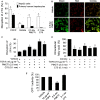Suppressed de novo lipogenesis by plasma membrane citrate transporter inhibitor promotes apoptosis in HepG2 cells
- PMID: 29928578
- PMCID: PMC5986055
- DOI: 10.1002/2211-5463.12435
Suppressed de novo lipogenesis by plasma membrane citrate transporter inhibitor promotes apoptosis in HepG2 cells
Abstract
Suppression of the expression or activities of enzymes that are involved in the synthesis of de novo lipogenesis (DNL) in cancer cells triggers cell death via apoptosis. The plasma membrane citrate transporter (PMCT) is the initial step that translocates citrate from blood circulation into the cytoplasm for de novo long-chain fatty acids synthesis. This study investigated the antitumor effect of the PMCT inhibitor (PMCTi) in inducing apoptosis by inhibiting the DNL pathway in HepG2 cells. The present findings showed that PMCTi reduced cell viability and enhanced apoptosis through decreased intracellular citrate levels, which consequently caused inhibition of fatty acid and triacylglycerol productions. Thus, as a result of the reduction in fatty acid synthesis, the activity of carnitine palmitoyl transferase-1 (CPT-1) was suppressed. Decreased CPT-1 activity also facilitated the disruption of mitochondrial membrane potential (ΔΨm) leading to stimulation of apoptosis. Surprisingly, primary human hepatocytes were not affected by PMCTi. Increased caspase-8 activity as a consequence of reduction in fatty acid synthesis was also found to cause disruption of ΔΨm. In addition, apoptosis induction by PMCTi was associated with an enhanced reactive oxygen species generation. Taken together, we suggest that inhibition of the DNL pathway following reduction in citrate levels is an important regulator of apoptosis in HepG2 cells via suppression of CPT-1 activity. Thus, targeting the DNL pathway mediating CPT-1 activity by PMCTi may be a selective potential anticancer therapy.
Keywords: HepG2 cells; apoptosis; de novo lipogenesis; plasma membrane citrate transporter.
Figures





References
-
- Koukourakis MI, Giatromanolaki A, Winter S, Leek R, Sivridis E and Harris AL (2009) Lactate dehydrogenase 5 expression in squamous cell head and neck cancer relates to prognosis following radical or postoperative radiotherapy. Oncology 77, 285–292. - PubMed
-
- Kayser G, Kassem A, Sienel W, Schulte‐Uentrop L, Mattern D, Aumann K, Stickeler E, Werner M, Passlick B & Hausen AZ (2010) Lactate‐dehydrogenase 5 is overexpressed in non‐small cell lung cancer and correlates with the expression of the transketolase‐like protein 1. Diagn Pathol 5, 22. - PMC - PubMed
-
- Fantin VR, St‐Pierre J and Leder P (2006) Attenuation of LDH‐A expression uncovers a link between glycolysis, mitochondrial physiology, and tumor maintenance. Cancer Cell 9, 425–434. - PubMed
LinkOut - more resources
Full Text Sources
Other Literature Sources

